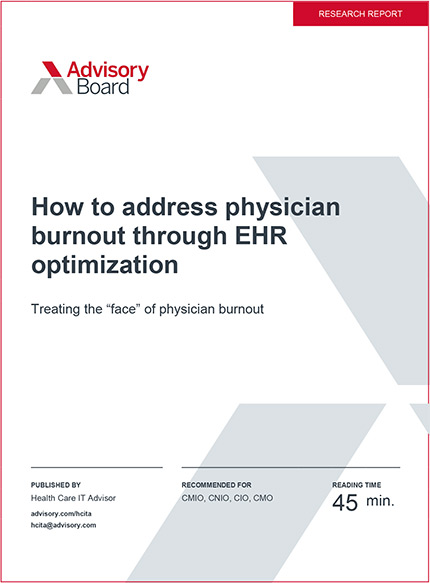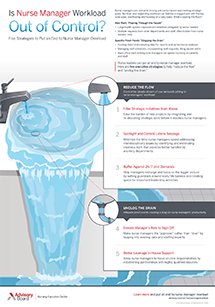Read Advisory Board's take: Is this truly the fault of hospital leaders?
The U.S. health system is "cynically manipulat[ing]" medical professionals' commitment to their patients to squeeze extra productivity out of an overwhelmed system—an approach that "is not just bad strategy" but "bad medicine," Danielle Ofri, a physician at Bellevue Hospital, writes in a New York Times opinion piece.
Ofri's provocative argument, which ran under the headline "The business of health care depends on exploiting doctors and nurses," appeared in the Times on Saturday.
The growing demand on medical professionals
The fundamental issue, Ofri writes, is that "[i]f doctors and nurses clocked out when their paid hours were finished, the effect on patients would be calamitous." As such, providers feel compelled to carry work home with them and to remain available to patients at all hours—a laudable work ethic that, Ofri argues, is now "being cynically manipulated" by the health system.
"I stop short of accusing the system of drawing up a premeditated business plan to manipulate medical professionalism into free labor," Ofri clarifies. Rather, as administrators try to squeeze every ounce of productivity out of the system, "[o]ne additional task after another is piled onto the clinical staff members, who can't—and won't—say no."
The biggest culprit, according to Ofri, is "the mushrooming workload" created by EHRs.
Ofri concedes that the EHR has afforded benefits, noting, "no one wants to go back to the old days of chasing down lost charts and deciphering inscrutable handwriting." But at the same time, the data entry that the technology necessitates is "mind-numbing and voluminous," Ofri states. She cites research showing that primary care doctors spend roughly two hours inputting information into the EHR for every hour they spend directly on patient care. She adds, "Most of us are now putting in hours of additional time each day for the same number of patients."
Ofri asks readers to consider what would happen if other industries saw a similar increase in workload. "In a factory, if 30% more items were suddenly dropped onto an assembly line, the process would grind to a halt," she writes. However, in the health care industry, "there is a wondrous elasticity—you can keep adding work and magically it all somehow gets done," Ofri writes. For instance, she notes that nurses will skip lunch if their ward is short-staffed, while doctors will "'squeeze in' the extra patients" when the situation demands it.
"For most doctors and nurses, it is unthinkable to walk away without completing your work because dropping the ball could endanger your patients," Ofri writes.
The situation is 'not fine'
Because doctors and nurses are—somehow—shouldering this extraordinary workload, Ofri writes, "[f]rom an administrative perspective, all seems to be purring along just fine."
But the situation, Ofri contends "is not fine." She cites a Medscape piece showing that burnout levels among physicians are at "new highs." She also points to research showing and that burnout among physicians is "far worse than among the general population."
The rise in burnout is not without consequence, Ofri asserts. For instance, she points to findings showing that "[h]igher levels of burnout are also associated with more medical errors and compromised patient safety."
A call to restructure health care
Ofri writes, "The health care system needs to be restructured to reflect the realities of patient care," noting the increase in health care administrators over the years. Specifically, she notes that the number of health care administrators increased 3,200% from 1975 to 2010, and that there are about 10 administrators for every doctor.
According to Ofri, "If we converted even half of those salary lines to additional nurses and doctors, we might have enough clinical staff members to handle the work."
In summary, Ofri calls for people "at the top" to "think about the ramifications of their decisions." She writes, "Health care is about taking care of patients, not paperwork" (Ofri, New York Times, 6/8).
Advisory Board's take

Veena Lanka, MD, Research Partner
The grim picture Dr. Ofri paints of the overwhelming workplace experience will no doubt ring true for most, if not all, doctors and nurses who serve patients in hospitals and clinics across US. One would be hard-pressed to find a clinician who actually gets out the door when their shift ends. Most routinely stretch their time, attention, and empathy further to do the right thing by their patients, at the expense of their personal well-being and family responsibilities.
Of course, this professional ethic isn't limited to healthcare—as teachers, social workers, firefighters, customer service specialists, and other public service professionals would attest. That said, the cost of provider burnout in health care specifically is far too dire to simply accept as an occupational hazard, as underscored by Medscape, Mayo Clinic, and the Annals of Internal Medicine recently.
Where my take diverges from Dr. Ofri’s relates to the hospital administrative leader role and viewpoint on this issue. We find that hospital administrative leaders are actually in the same boat right alongside clinicians in trying to fix this problem. Looking back at dozens of conversations I've had with Chief Medical Officers, the two questions I'm asked most often are:
- "How can we reduce unwarranted services that don't benefit our patients" and;
- "How can we improve our provider wellbeing?"
The former puts the patient first and the second puts the providers first—as it should be. This is why I can't share Dr. Ofri's cynicism that overwork of clinicians is driven by malicious design and corporate greed on the part of hospital leaders.
Instead, I see the real story here being a perfect storm of diverse kinds of changes that have crept up on providers in modern medicine. Recent years have seen clinician's roles expand to include all of the following:
- Responsibility for extensive documentation in poorly designed EMRs;
- Navigating new challenges in patient experience and public relations triggered by publicly available reviews;
- Declining reimbursements;
- New demands to navigate reimbursement challenges (from growing demands for prior authorizations to helping patients navigate their increasing cost exposure);
- Additional regulatory and reporting requirements; and
- Increasing complexity of care teams, delivery systems and therapies.
Probably the biggest contribution that hospital and health system leaders have made to these problems is that, in the name of various system performance improvement and transformation initiatives, they have added more tasks and expectations to their staff's plate without pausing to take away any redundant or outdated ones. Most of these initiatives are worthy; it's just that the entirety is too much to handle all at once.
Therefore, we see three main steps that hospital leaders should double down on to support their frontline staff in this new era of medicine:
- Engage performance improvement teams to review workflows and eliminate redundant steps. Care expectations are in need of a good 'declutter'—and not just once, but as an ongoing discipline. Hospitals can leverage their performance improvement teams to review frontline staff's workflows and trim the excesses that do not contribute to patient outcomes and detract from provider well-being. To learn more on how to launch these efforts, view our study on Combating Physician Burnout.
- Redesign care team models to enable each professional to perform at the top of their license. Hospital leaders should review their care team models and deploy APPs and scribes appropriately to make sure that all staff are able to take on the tasks that are most appropriate for their role—and likely most meaningful to them. Learn more about how to develop a scalable, high value APP model with our toolkit.
- Launch clinician-directed efforts to streamline the EHR. Involve clinicians in efforts to remove meaningless alerts and documentation requirements from EHR systems. Learn more about how to optimize your EHR with clinicians, with our new report.
Clinicians and administrators: The takeaway here is that both sides should come together to explore the problems and identify real solutions. If we take steps such as the ones outlined above, it is possible to build the kinds of organizations where each professional is better able contribute at the top of their license—a win for the clinician, the system, and patients.
Don't miss out on the latest Advisory Board insights
Create your free account to access 2 resources each month, including the latest research and webinars.
Want access without creating an account?
You have 2 free members-only resources remaining this month remaining this month.
1 free members-only resources remaining this month
1 free members-only resources remaining this month
You've reached your limit of free monthly insights
Become a member to access all of Advisory Board's resources, events, and experts
Never miss out on the latest innovative health care content tailored to you.
Benefits include:
You've reached your limit of free monthly insights



